#bradford pear fruit
Explore tagged Tumblr posts
Text

It's December and it might seem like fruit season is pretty much over for most of the eastern half of the US, but it's a good time to look for bradford/callery pears! (AND it's a good time to eat the fruit to curb their spread, as a highly invasive plant!)
Here's a page from my fruit foraging zine, FRUIT FOR FREE. You can download the whole book from my ko-fi page if you want to see more!
1K notes
·
View notes
Text



Acorn Anne visits some Mulberry trees that are in need of healing. please send a small offering of dry, warm air through your closest fairy ring and Acorn Anne will direct it to the leaves of both trees. thank you for your cooperation 🫡
#ok i learned the fungus on my trees is not life threatening and is worse in wet summers#apparently stronger and healthier trees are more resistant to it too#which if the rest of the neighborhood is anything to go by i think my trees are a bit healthier#that is good to see#they need a good trim though#anyway send dry air it might rain this week which i do love bc we always need rain in texas#but if you send the dry air in the fairy ring acorn anne can reserve it for next summer and maybe they can be healthier then#since its almost autumn rn anyway#actually send me some spoons through the ring too bc i need to trim their branches and rake the fungus leaves up#i dont plan on raking the normal autumn leaves but apparently keeping the fungus leaves off the ground can help#thank you in advance for any contributions you make ok love you byeeee#my clown#acorn anne syrup#clownblr#clownin around#clown shenanigans#clown doll#porcelain clown doll#PS if you send dry air through the portals i will also have Acorn Anne send you back any mulberries we happen to get if any#i have NO clue if these trees will produce fruit lmao i have no experience with mulberry trees at all#even though apparently these are native to my area#seems like in the 60s they still planted native trees instead of *clenches fist* bradford pears#unreality
9 notes
·
View notes
Text
I always think I’m not weird about food, but then I realize that I’m grading on a curve based on how weird I could be about food, considering family history and various medical conditions and society and all.
#I think some of the weirdnesses cancel each other out#also some of it isn’t bad per se#I eat orange peels for example#and Bradford pear fruits#and as a child I ate grass
2 notes
·
View notes
Text

Oh yeah also I had to stop the truck in the middle of the driveway and roll down the window to get this pic today because omg
#she speaks#my goats#my horses#that’s almost my entire herd#the Bradford pears all over the area are in full bloom and they’re so beautiful#including mine#she’s even got some babies blooming on the other side of the fence ❤️#some people call them nuisances but I love them#and I love when the waxwings come in to eat the fruit in spring#god I love spring I’m so ready
3 notes
·
View notes
Text
More complete list of ways that websites and books about gardening shamelessly misinform and confuse people
Using any combination of cultivar names, species names, genus names, and common names to refer to plants, leaving well-intentioned gardening noobs fighting for their lives in a lawless wasteland. Just look at this Better Homes and Gardens article on salvia.
Salvia is a genus of plants containing hundreds of species, including culinary sage, rosemary, and many species used as ornamentals. The Better Homes and Gardens list ruthlessly mixes common names for sage species with cultivar names, without giving the binomial Latin species name at all for a single one...




...and refers to two totally different plants only as "purple sage" in the same listicle


On that note, acting like "variety" is just as important as, or interchangeable with, "species." Just read an article that said "some varieties of this plant can be invasive, so make sure to check which ones are prohibited in your area!" No. NO. No specific cultivar of an invasive plant species is going to be non-invasive. In fact, introducing new cultivars of an invasive plant will make the invasive species problem WORSE because that's new genetic material. 'Bradford' pears are invasive in the US, 'Cleveland' pears are also invasive, because they're BOTH PYRUS CALLERYANA, but the website you're buying them off of doesn't SAY that, AUGHH
Referring to plants that are enthusiastic or aggressive growers as 'invasive.' I falsely believed so many native species were invasive simply because some dumbass article decided to call them "invasive" for the crime of being able to grow in a lawn. The same websites will turn around and say that a 100% virulent invasive species "can become aggressive in some gardens" WHSFDHHKKK???
Gardening books describing a gorgeous native flower that doesn't die instantly when you think a negative thought about it: "Invasive. Evil. Kill on sight." Gardening books describing one of the worst known invasive plant species in human history that's decimating ecosystems as we speak: "This plant can be a teensy weensy bit vigorous."
totally failing to explore what it means for a cultivar of a plant to be "sterile." Here's the thing. The 'Bradford' pear was supposed to be sterile, but it was not, the cultivar was just made up of clones of the same plant, and most plants can't fertilize themselves. When another cultivar of Pyrus calleryana is planted close to it, such as the 'Cleveland' pear, surprise surprise, THEY AREN'T STERILE.
IIRC it is possible to produce truly sterile cultivars by breeding a plant that can't make seeds/fruits and cloning those plants by vegetative propagation. A cultivar of cloned, genetically identical plants with completely unchanged reproductive ability is NOT STERILE, it is just banking on no other cultivars of the plant ever existing nearby. Which is deeply stupid.
Yes, "cultivars" (the names in single quotation marks next to the name of the plant in a nursery label) are generally just groups of clones of the same founding individual. I'm not a fan of cultivars because they're basically Petri dishes for breeding disease. E.g. The Emerald ash borer was able to so thoroughly decimate ash trees in the USA partly because the gene pool of planted ash trees in American cities was 2-3 individual trees big. Now ornamental boxwoods seem to be dying off en masse in my area, and the reasons are probably similar.
800 notes
·
View notes
Text
PSA: FUCK CALLERY PEARS!!!

The callery pear, sometimes known by the name of its infamous domestic cultivar, the Bradford pear, is a HIGHLY invasive species throughout the US! At this time of year (late winter to early spring), callery pears bloom and leaf out before any other native tree species, which can lead to overcrowding.
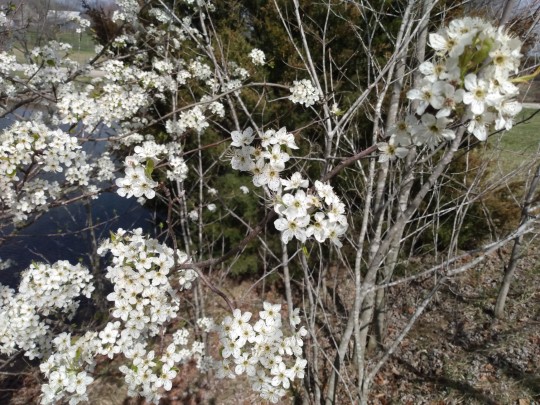
The history of the Bradford pear:
The Bradford cultivar of the callery pear was introduced into the United States in the 1960s as the ultimate ornamental tree: it flowers and leaves out early, it is naturally straight and tall, and grows super quick. Its leaves are deep red in fall and its toxic fruits are candy to birds. But these attributes would lead to it being a highly invasive species. Where I live, these trees are already greening up when most grass is still barely colored. The fact is that these trees fill in before any others, crowding out younger native plants.
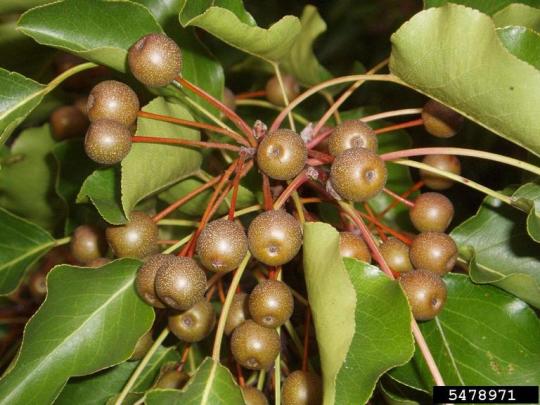
(image courtesy of Leslie Mehrnoff)
Then there are the growing habits of the Bradford pear. The Bradford was originally praised for its rapid, even growth. However, these trees grow so fast that they can't build as much strength as slower-growing species, such as oaks. The forks in limbs and branches are the weak spots, and any amount of wind sends down showers of twigs. When I was younger, I lived in a house with three of these invasive shits out front, and it was a hassle to constantly pick up branches and twigs from the lawn.
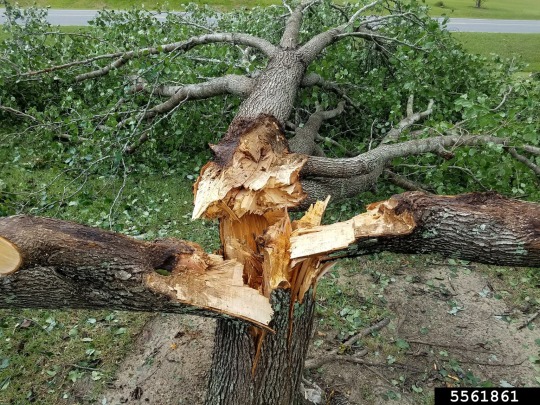
(image courtesy of Rebekah Wallace)
As a result of their accelerated growth, Bradford pears are HIGHLY susceptible to storm damage, and this can hurt houses, automobiles and other people's property. On top of that, they're not very pretty to look at whenever they're not flowering or colored up for fall.
WHAT YOU CAN DO:
Pull/dig up any suckers or saplings that you find. Beware that wild-type callery pears have thorns on the ends of their branches, so proceed with caution.
Cut them the hell down. Depending on where you live, you may receive payment or even a free native tree for pear trees you cut down. Note, DO NOT cut down trees on others' property without permission from the owner of said property.
Inform others! The best way to stop the spread of these trees is to teach others about the problem! More people cutting down callery pears means less shitty invasive trees!
Thank you for your consideration!
#I forgot to mention their flowers smell like human semen so#do what you will with that info#callery pear#bradford pear#invasive species#invasive plants#conservation#plantblr
129 notes
·
View notes
Text
‼️This is a callout post‼️
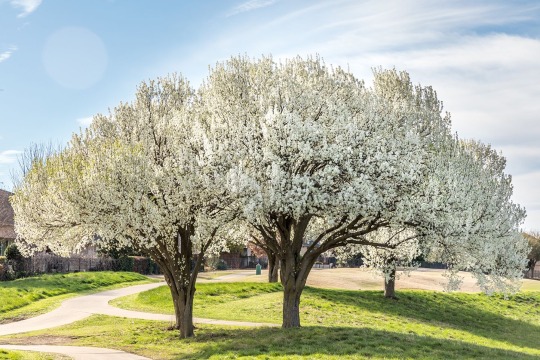
I hate these guys I hate them so much like actually who decided to start planting Bradford Pears they have Zero good qualities I HATE THEM SO MUCH
So here’s some reasons why you should get rid of these:
They smell like a fish market on a hot summer day but all the fish are a week old
The flowers aren’t that cool like sorry there’s plenty of other trees with white flowers
They are BRITTLE. SO BRITTLE. One gust of wind and your tree is GONE.
They will breed with anything. Whore tree. They cross-pollinate to a point where they become incredibly invasive. And also when they do that they grow thorns and get super ugly 👍
THEY’RE PEAR TREES THAT DON’T EVEN GROW PEARS
Did I mention they smell like fish
‼️‼️‼️‼️‼️‼️‼️‼️‼️‼️‼️‼️‼️‼️‼️ If you have Bradford Pears that you can cut down you should cut them down
Some US states will give you a free tree to replace them with
Here are some better trees to plant in your area:
*these are US based recommendations because I’m pretty sure the US is the only place with Evil Bradford Pear Problems*
Magnolias! They smell amazing and have great flowers. They’re native to Florida but will survive in most of the southeastern US
Dogwoods! There’s both an eastern and a western variety and both are native to North America! Just make sure you get the right type for where you live (east vs west)
Pawpaws! These trees bear fruit, are great for pollinators, and their native range spans about half of the United States
Redbuds! Similar to Dogwoods, there’s both an eastern and western variety. Also native to North America, they’re one of the first trees to bloom in spring
Serviceberry! YOU CAN EAT THE BERRIES!!! Also native to North America, they can survive in a ton of different climates and are great for pollinators
You can find more native trees here
This has been a Bradford Pear Hate Post
34 notes
·
View notes
Text
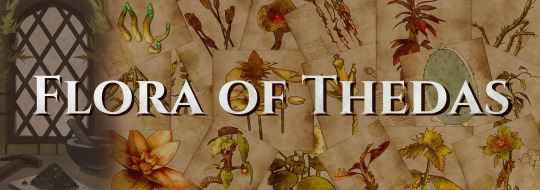
ALT
Flora of Thedas Master List
Master list of all the flora in Thedas, mentioned or seen.
Additional notes on certain items will be listed at the bottom, for items marked with asterisks, see the key below for a brief explanation and the Game assets and Additional Notes and Trivia section at the bottom. Sources are listed at the very end and this time linked.
For other lists here are posts for: Real Plants in Thedas
Key: * - Name comes from the asset file name ** - Name not provided but identified based on the textures used on the asset. *** - See Additional Notes and Trivia.
General Flora: Flowers and Foliage
Acacia*: Black Wood*
Andraste's Grace
Ardent Blossom
Ash
Aspen
Banyan Tree*
Barbwood
Beech Tree
Belladonna
Birch: White Birch*
Blackthorn
Bluebell
Borage
Boswellia
Boxwood*
Buttercup
Cactus: Pear Cactus*
Cattail*
Cedar: Red Cedar
Chicory
Clover: Forest Clover*
Coleus**
Cosmos
Cotton
Crape Myrtle
Cypress: Italian Cypress*, Topiary Cypress*
Daffodil
Daisy: Marguerite
Dandelion
Dog-rose
Dogwood*
Elephant Ear*
Elm
Fade Berry*
Felicidus Aria
Fern: Red Fern*, Sword Fern*
Fir
Flax
Foxleaf*
Frangipani
Gorse
Harlot's Blush
Hawthorn
Hay
Hemp
Hensbane
Hero Tree*
Hollyhock
Honeysuckle
Iris
Ironbark
Ironwood***
Itchweed
Ivy
Jasmin
Larch
Lichen: Glowing Lichen
Lilac
Lily: Calla Lily**, Water Lily
Lotus
Maple
Marigold
Moss: Oakmoss, Redmoss, Tree-Moss
Nightshade
Northern Prickleweed
Oak: Serault Oak
Orchid
Palm Tree: Curly Palm*, Fan Palm*
Pansy
Peony
Pine: Chir Pine*, Stone Pine
Ponga Tree*
Poppy
Prickle-burrs
Redwood*
Rose: Climbing Rose
Rowan
Sandalwood
Seaweed
Snapdragon
Spruce
Sugar Cane
Sundew
Sunflower
Sylvanwood
Tahanis
Thistle
Trex*
Trullium
Vasanthum
Violet
Walnut: Black Walnut
Waterweed*
Wilds Flower
Willow
Witchhazel*
Wysteria
Yew
Fruits
Apple: Applewood Apple, Green Apple, Golden Apple, Red Apple
Apricot
Banana
Berries: Blackberry, Blueberry, Bramble Berry, Cranberry, Elderberry, Raspberry, Strawberry
Cherry
Citron
Coco, Chocolate
Coconut
Coffee
Currants: Black Currant
Fig
Grape
Lemon
Lime
Melon
Nuts: Almonds, Chestnut, Hognut, Peanuts
Olives
Orange: Sweet Orange
Palm Fruit: Date
Passion Fruit
Peach
Pear: Bradford Pear*
Plum
Pomegranate
Grains
Barley
Oats
Rice
Ryott
Wheat
Vegetables
Artichoke
Beans: Bush Bean, Green Bean, Pale Bean, White Bean
Beets
Bell Peppers: Red Bell Peppers
Cabbage
Capers
Carrot
Celery
Chive
Corn
Cucumber
Daikon Radish*
Eggplant
Fennel
Onion: Red Onion, Sweet Onion, White Onion
Pea
Peppers: Antivan Pepper, Green Pepper, Hot Pepper, Hot Red Pepper, Sweet Pepper
Potato
Radish
Spinach
Squash: Baby Pumpkin, Marrow Squash, Pumpkin, String Squash
Tomato
Turnip
Fungus of Thedas
Deep Mushrooms
Bleeding Russula
Blightcap
Blighted Morel
Brimstone Mushroom
Deep Mushroom
Destroying Spirit
Ghoul's Mushroom
Unnamed Mushroom Ortan Thaig
Surface Mushrooms
Beetle Spore
Drakevein
Field Mushroom
Gasbloom*
Sponge Root***
Toadstool
Truffle
Morel***
Unnamed Glowing Mushroom***
Unnamed Mushroom***
Spices
Allspice
Antivan Cord-Seed
Cardamom
Cinnamon
Clove
Cumin, Cumin Seed
Dill, Dill Seed
Juniper
Licorice
Mace
Mustard
Nutmeg
Pepper: Black Pepper
Peppercorn: Black Peppercorn
Saffron
Vanilla

ALT
Herbs of Thedas
Herbs count as anything that Dragon Age has classified as an herb (whether technically correct or not), plants that are used as herbs in real life. These do not include mushrooms, fungi, or deep mushrooms simply for ease of organization.
Amrita Vein
Andraste's Mantle
Arbor Blessing
Basil
Bay
Catsbane
Crystal Grace
Deathroot: Arcanist Deathroot, Lunatic's Deathroot
Dragonthorn
Elfroot/Canavaris: Bitter Elfroot, Gossamer Elfroot, Royal Elfroot
Embrium: Dark Embrium, Salubrious Embrium
Felandaris
Foxite
Garlic
Ghoul's Beard
Ginger
Heatherum
Lavender
Lotus: Black Lotus, Blood Lotus, Dawn Lotus
Madcap
Mint: Anderfel's Mint, Foxmint, Peppermint
Mintroot - Not a true mint based on its description and the fact that it grows on trees.
Oregano
Parsley
Prophet's Laurel
Rashvine
Rashvine Nettle
Redleaf
Rosemary
Sage
Spindleweed: Verdant Spindleweed
Stripweed
Thyme
Vandal Aria
Winterberry***
Witherstalk
Star Anise
Wormwood
Wormroot***
Game Assets Notes
These are plants shown in Dragon Age but aren't named in universe, just in their model files or through identification of the textures. Since most filler plant textures are just that of real world plants.
**NOTE:** When I mention they are not the known name of any plant, this comes with the caveat of being popular common names. Common names are highly variable and inconsistent. They depend on regional knowledge and association. Some travel farther than others. Common names are also not reliable identifiers.
Acacia: Black Wood ~ Note: Black Wood is a type of acacia. Both acacia and black wood are named assets.
Artichoke ~ Note: Identification comes from asset name, the artichoke flower is used as ornamentation of a box.
Banyan Tree
Boxwood ~ A type of shrub, identification comes from asset name.
Bradford Pear ~ Their fruits are edible, however their flowers are known to emit a smell akin to rotting meat. Identification comes from asset name.
Calla Lily ~ Note: Not named but identified by the texture used. It is seen in Val Royeaux planters.
Cattail ~ Note: Seen through out DAO and DAI, identification comes from asset name.
Coleus ~ Note: Not named but identified by the texture used. It is seen in Val Royeaux planters and in the Frostback Basin.
Crape Myrtle
Cypress: Italian Cypress, Topiary Cypress ~ Note: In terms of the Italian Cypress, in world it wouldl likely be called the "Antivan Cypress" given that Antiva is pulling from Italian culture, food, environments, and other inspirational elements. Cypress is a plant that is named in canon.
Daikon Radish ~ Note: Found on Dennet's farm, identification comes from asset name.
Dogwood
Elephant Ear ~ Note: Foliage found in the Frostback Basin, identification comes from asset name.
Fade Berry
Fern: Red Fern, Sword Fern ~ Note: The red fern isn't a real plant and therefore can be considered unique to Thedas. In contrast the sword fern is a real plant. Identification comes from the asset name for both of these ferns.
Forest Clover
Foxleaf ~ Note: This is another plant that is not real, no plant has this common name as far as I could find.
Gasbloom ~ Note: Seen in the Arbor Wilds, the Frostback Basin some elven ruins, and the elven ruins of multiplayer levels. Their identification comes from the asset name. There are two versions of the texture the "fixed" version is used in JoH dlc and thus explains the difference in appearance. This is not the name of a known mushroom.
Hero Tree
Palm: Curly Palm, Fan Palm ~ Note: Both palms are seen in the Frostback Basin, both are identified by their named assets.
Pear Cactus ~ Note: Found in the Frostback Basin, identification comes from the asset name.
Pine: Chir Pine
Ponga Tree ~ Note: Also known as the 'Tree Fern'. This is the tree you see in Val Royeaux garden as coming from Par Vollen, and throughout the Arbor Wilds.
Redwood ~ Note: Identified by the name of the file asset. Found in the Winter Palace, Exalted Plains, and on multiplayer maps.
Snapdragon
Trex
Waterweed ~ Note: In real life this is an entire genus not one particular plant. Though the six plants in this genus do share the common name of waterweed.
White Birch
Witchhazel
Additional Notes and Trivia
Ironwood - Unclear if this is an alternative name, the actual name of the plant, or both.
Morel - This mushroom is inferred due to the existence of Blighted Morel. However it is not explicitly specified there is a non-blighted morel.
Sponge Root - Though canonical as it is mentioned and shown in World of Thedas vol. 2 on pg. 138 with a collection of deep mushroom and surface mushroom illustrations. This mushroom was cut twice from Inquisition. It was cut from the base game as a craftable, it had a much different appearance from its final design, and then it was cut again from Trespasser. It does however still make an appearance in Inquisition as the inventory icon for Crystal Grace.
Unnamed Glowing Mushroom Is mentioned in multiplayer when there are two Lukas playing.
Unnamed Mushroom These brown mushrooms are seen in the Fallow Mire and the Frostback Basin. They are shown in two different sizes ranging from shorter than a dwarf to taller than one.
There is one unlisted mushroom, its assets is named "red mushroom" and thus is identified by textures. These is not a canon name but is included for completeness. Amanita Muscaria: More commonly know as fly agaric or fly amanita, the red top with white spots is an iconic in its imagery. You will find large swaths of these mushrooms in the Frostback Basin. Their assets is named "Red Mushroom".
Winterberry is a real plant. However, from what we see in DA2, it does not the same as the plant we have in the real world, just a shared common name.
Wormroot is another real plant name. However, due to the description in The Calling, it does not seem to be the same plant. In The Calling it is used to treat the venom of a giant spider. The real world plant is used to treat parasites in the gut and does not seem to hold any shared uses in folk lore, folk medicine, or western medicine practices.
Sources
Dragon Age Origins + DLCs Dragon Age 2 Dragon Age Last Court Dragon Age Inquisition + DLCs Dragon Age TTRPG Core Rulebook Dragon Age TTRPG Blood of Ferelden Dragon Age TTRPG: Creatures of Thedas: Wyvern
World of Thedas Vol. 1 and Vol. 2 Dragon Age: The Stolen Throne Dragon Age: The Calling Dragon Age: The Masked Empire Dragon Age: Last Flight Dragon Age: Tevinter Nights Short Story: Paying the Ferryman Short Story: Riddle in the Truth Short Story: The Wake
Origins Andraste's Grace Codex: The Bercillian Forest Codex: Falon'Din: Friend of the Dead, the Guide Codex: Feast Day Fish Codex: The History of Soldier's Peak: Chapter 3 Codex: Ironbark Codex: A Note from the Honnleath Village Council Codex: Sylaise: The Hearthkeeper Codex: Sylvan Codex: A Tattered Shopping List Item: Concentrator Agent Item: Deep Mushroom Item: Figurine Item: Madcap Bulb Item: Rare Antivan Brandy Item: Rashvine Nettle Item: Spirit Charm Item: Spirit Cord Item: Sugar Cake Item: Swift Salve Item: West Hill Brandy Item: Wilds Flower
DA 2 Ambrosia Bianca (Crossbow) Ironwood Clearing Codex: Deathroot Codex: Deep Mushroom Codex: Embrium Codex: Felandaris Codex: The Hedge Witch Codex: Spindleweed Item: Carved Ironwood Buttons Item: Harlot's Blush Quest: Hard to Stomach Quest: The Long Road Quest: Tranquility Weapon: The Celebrant Weapon: Ironwood Shield Weapon: Ironwood Warblade
Inquisition Codex: Amrita Vein Codex: Arbor Blessing Codex: Avvar Cuisine Codex: Black Lotus Codex: Blood Lotus Codex: Bottles of Thedas Codex: Crystal Grace Codex: Elfroot Codex: Ghoul's Beard Codex: The Girl in Red Crossing Codex: Hard in Hightown Chapter 7 Codex: Hard in Hightown Chapter 10 Codex: Mediations and Odes to Bees Codex: Notes on Palace Guests Codex: The Orlesian Civil War Codex: Prophet's Laurel Codex: Rashvine Codex: Rashvine Nettle Codex: Vandal Aria Codex: Vivienne's Alchemy Notes Codex: Waterlogged Diary Codex: Witherstalk Note: Betta's Traveling Journal Note: Carta Note on Security Note: Field Notes Note: The Gilded Horn's Drink List Note: Knight-Captain's Orders Note: Love Letter Note: A Note from Skyhold's Kitchens Note: A Note from Skyhold's Kitchens, Again War Table: The Dance with the Dowager: The Allemande Item: Ardent Blossom
Last Court The Abbess' Road The Anchoress Arrival of the Divine The Feast is Ending Fires Flames of Freedom Good Neighbors Heartwood Feast The Hounds The Lord of the Wood Comes a-Calling The Purveyor of Teas Road and River A Swift Stream Thieves! Unofficial Meeting
Want to support this blog? Check out my ko-fi!
#dragon age#flora of thedas#herbs of thedas#writing resource#resource: plants#resource: flora#long post#lore#flora friday#floral friday
152 notes
·
View notes
Text
OC Interview!
I was tagged by @henbased and in turn I’ll tag @chaosintheavenue @bleumanouche @captastra and @tarberrydovah
Also I’m gonna do three sorry I know it’s excessive but. I love them.
Name: Emil Hawke
Nickname: N/A
Gender: guy but in a I don’t really care kind of way
Star Sign: cancer, 100%
Height: 5’6
Orientation: bisexual if you want a label but really hasn’t had the time to think about it between all of the running for his life
Nationality/Ethnicity: ferelden
Fave Fruit: oranges, which he’s probably only had like once.
Fave Season: winter!
Fave Flower: those little ones on Bradford pear trees!
Fave Scent: Anders magic, kind of like a mix between ozone and burning green wood
Coffee, Tea, or HC: Tea, preferably a borderline unbearably sweet herbal tea
Average Hours of Sleep: like. 1-4? Insomnia <3
Dog or Cat Person: Dog!
Dream Trip: Kirkwall (hell) to Rivain (his girlfriend is from there)
Favorite Fictional Character: himself, Varrics version of him is the funniest character on the planet.
Number of Blankets They Sleep With: by himself like as many as he can handle, with anders or isabela just like one. He just likes the weight
Random Fact: He doesn’t have a preferred ‘normal’ magic, the only one he’s exceptional at is blood magic.
————
Name: Noose
Nickname: Six (Rangers) Courier/Courier Six (Ulysses, Benny and people who don’t know them well)
Gender: Lost somewhere between Bethesda and Phoenix
Star Sign: Capricorn? Idk anything about star signs
Height: 5’3
Orientation: Queer
Nationality/Ethnicity: I’m not sure on Ethnicity but I think technically they’re an NCR citizen due to how much time they’ve spent there
Fave Fruit: Punga
Fave Season: the absolute dead of summer when everything is so hot the world kind of feels like a fever dream
Fave Flower: Dandelions something something about resilience
Fave Scent: ozone, like a thunderstorm.
Coffee, Tea, or HC: coffee for sure
Average Hours of Sleep: as little as humanly possible
Dog or Cat Person: Cat but they love dogs too, they have a lot more dogs bc they travel easier in the wasteland
Dream Trip: they’ve travelled all over the American wasteland but they’d like to go north into Canada if given the chance
Favorite Fictional Character: Grognak
Number of Blankets They Sleep With: preferably, 3, realistically none
Random Fact: they have a luck stat of 10
————
Name: *********
Nickname: Skunk
Gender: Dude
Star Sign: ???
Height: 6’0
Orientation: ???
Nationality/Ethnicity: white American
Fave Fruit: purple plums
Fave Season: Fall!
Fave Flower: Queen Anne’s lace
Fave Scent: oddly enough chlorinated water, like over chlorinated pool water
Coffee, Tea, or HC: blueberry redbull
Average Hours of Sleep: as many as he can manage
Dog or Cat Person: Dog
Dream Trip: the one that gets him the fuck out of Montana
Favorite Fictional Character: probably like. Red hood or something.
Number of Blankets They Sleep With: honestly he just needs and wants one.
Random Fact: almost didn’t take the job in the whitetails, he regrets it every day of his life :)
5 notes
·
View notes
Text
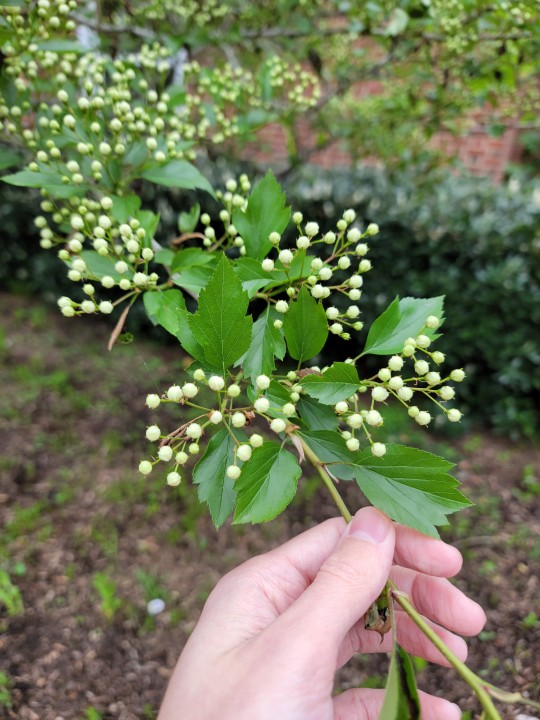

Happy Earth Day and Passover everyone!
Today I'm going to give you an easy tea recipe, from a family of trees that's deeply important to my family and many other Irish people: The Hawthorn
I'll cover the cultural significance more in a plant profile post in the coming weeks (when I can actually find a Hawthorn with spikes, cities don't have 'em).

The Hawthorn, aka Whitethorn or May flower, (flowers literally called: bán na Bealtaine or white of may in Gaelic) are short/sometimes shrubby trees usually grown wild in hedgerows. Many legends conflate the scent of the flowers to that of death...which isn't really true its more like a soft Bradford-pear scent...the tea's flavor is actually very light and earthy, reminiscent of nettle.
Don't let my description scare you, please follow my lead. Hawthorn blossoms and the non-fruit portions of the tree are only palatable early in spring, for this tea only take young leaves and flowers, one cluster myself, Wash this and boil it in hot water for 10 minutes. Be warned this may have a negative interaction with heart medicine if consumed in large quantities, Hawthorns have some research which shows the possibility of lowering blood pressure.

Recipe:
6-7 Hawthorn flowers and young green leaves taken in early spring, usually late april-may in europe, and the northern areas of North America
Wash thoroughly of any contaiminants that may have collected through the day
Place In boiling water for 10-15 minutes until green
Enjoy, let me know if you like it!
6 notes
·
View notes
Note
20 for the ask.
Also, I hope you don't mind me saying, but in my mind I feel like you would cultivate a pear orchard. But not your garden variety green pear, something with a little flourish. Sweet, late summer Starkrimson pears. Yeah. It's just the vibes.
What kind of orchard would you cultivate?
Oh, what a lovely thought! I adore pears, one of my top 5 fruits for sure. There were rows of Bradford pear trees surrounding my childhood house (which, unfortunately, hardly ever produce actual fruit, though they do have lovely flowers). Also I'd like to share this quote by Edward Bunyard: "The pear must be approached, as its feminine nature indicates, with discretion and reverence; it withholds its secrets from the merely hungry." The idea of the pear having an obvious "feminine nature" is quite funny, but I love that last bit. It withholds its secrets from the merely hungry. You cannot truly understand the pear just by eating it.
Really, I would want either a persimmon or a fig orchard. Persimmons because we also had a persimmon tree growing up that did fruit and so was an endless source of delight for me and all the other neighborhood kids; and figs because the only plant I've ever taken care of myself and never managed to kill was a fig tree, so they might actually be able to survive me.
14 notes
·
View notes
Text
An ode to allergies
What wonders fill the Springtime air! The breezes filled with filmy grit, And fetid breath of Bradford pear, And fruit trees fed with mounds of shit
To coax the fruit from fragile flower. Green and yellow pollen stains Are flushed with every pulsing shower Into catkins clumped in skeins.
Perhaps your elders coyly speak In metaphor of birds and bees. "Behold!" The ancient alders creak. "The gruesome mating of the trees!"
2 notes
·
View notes
Text
Callery Pear Tree Invasive Species
Callery pear trees (Pyrus calleryana), native to China and Vietnam, have been popular ornamental trees for almost 200 years. These trees were introduced to the United States in the 1800s and are often planted along streets and sidewalks because of their attractive form and coloration. This species is also known for its disease resistance (particularly fire blight resistance.) However, Callery pear tree is an invasive species, so much so that nurseries will no longer be allowed to sell the plant in Pennsylvania in 2024.

Callery Pear Tree Appearance
Callery pear has a distinctive appearance with crucial aspects that can help homeowners and plant health care experts quickly identify the plant.
Size: Callery Pear trees typically grow to around 16 to 26 ft tall, or approximately 5 to 8 meters, often with a conical to rounded crown.
Leaves: The leaves are oval-shaped and about 1-1⁄2 to 3 inches long, with a dark green color in early spring before the leaves turn yellow, orange, or red in the fall.
Flowers: The flowers are white and grow in clusters, have about five petals, and are about 3⁄4 to 1 inch in diameter.
Fruits: The fruits of the Callery pear are small, less than 3⁄8 of an inch in diameter. In addition, the fruits have a rugged, almost woody feel but are softened by frost, after which birds readily consume them.
Damage Caused by Callery Pear
Callery pear trees are invasive plants in many parts of the country and have damaged the landscapes and gardens of Pennsylvania homeowners. One of the significant reasons Callery pears cause so much damage is how the trees grow. These trees form dense thickets which displace native plants and animals. The dense thickets push out native trees or other plants that may compete with the Callery pear for water, soil, and space.
In addition, some cultivars (a type of cultivated plant that people have selected for desired traits), such as the ‘Bradford pear,’ are susceptible to storm damage, becoming disfigured or killed by strong winds and winter weather. So there is also a risk of the branches falling during strong winds and storms and damaging other things around the tree, like property or people.
What Makes Callery Pear an Invasive Plant
Like other species of plants we have discussed in this series, Callery pear has many qualities that enable the tree to spread quickly. One primary reason is the fruits discussed previously. The tree species produce large quantities of fruits that birds consume, and then those birds fly and relocate to new areas, passing the seeds in droppings into the soil, allowing new Callery pear trees to grow.
What makes Callery pear unique among the other invasive plant species we have talked about is the role of cultivars in spreading its population. Cultivars were initially bred to produce sterile fruit. However, different varieties can cross-pollinate, which results in viable seeds. When these cultivars grow close enough to each other to cross-pollinate, the trees produce fertile seeds that can sprout once dispersed.
Treating & Controlling Callery Pear
Callery pear can be challenging to control, but some methods exist for managing or removing the population from a landscape.
Small plants and their roots can be removed by hand, but larger trees require more extensive removal with specialized equipment, and herbicide application must be used as a follow-up.
Foliar herbicide applications can be done from around mid-May to early-mid October. These foliar treatments are ideal for landscapes with a low to moderate density of trees, which are less than 10 feet tall.
Basal bark treatments can be applied to the stems of a Callery pear tree throughout the year, with some exceptions (particularly during snow or rainy weather.)
As always, these control and treatment options require specialized, extensive knowledge of plant health care techniques. So call a plant health care expert if you need help with Callery pear in your landscape.
Contact Burkholder PHC for Expert Treatment of Plant Health Care Issues
The Callery pear tree invasive plant can overtake landscapes, and its dense thickets prevent native plant species from growing. To keep your landscape and native species healthy and able to thrive, we recommend a professional evaluation to help remove the plant and control any adverse effects. Our evaluation is free, and the proper treatments can help improve the health of your landscape. Contact Burkholder PHC today for a free consultation.
Blog is originally published at: https://www.burkholderphc.com/callery-pear-tree-invasive-species/
It is republished with the permission from the author.
0 notes
Text
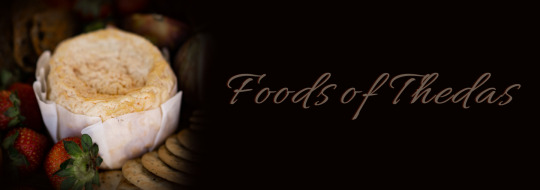
Canonically Suggested Foods and Ingredients
Updated: 2023/12
As of now, this list is updated with everything found in media released as of Oct 2023.
Like the original, this contains all ingredients that exist in Thedas and are either mentioned, referenced, or suggested in someway but are not explicitly mentioned as being eaten. Though there is little to suggest that they wouldn’t be.
For Other Food Posts
Dishes, Sauces, and Sides
Drinks
Raw Ingredients
Prepared Ingredients
Food and Drink Master Post
Disclaimer
Though real life plants may be listed here as edible, it is for fictional use only. This is not intended to be used as a reference nor guide for what plants are edible or safe to eat. Please do not use it as such.
Dishes
Boiled Cabbage
Posset - In the terms of a cold dessert made from thickened cream and commonly flavored with lemon. As we see, the medicinal alcoholic drink mentioned in The Last Court.
Sponge Cake
Chocolate Sponge - Mentioned by Leliana in dialogue with a runner.
Raw Ingredients
Edible Plants, Fruit, and Vegetables
Edible Plants
Aspen - The inner bark is sweet and starchy. It is edible both raw and cooked, it can also be dried and ground into flour. Some aspens have edible catkins as well.
Beech - The young green spring leaves can be cooked as greens. The inner bark, once dried, can be turned into bread flour.
Birch - The inner bark can be dried and used to make bread flour. Strips of the inner bark could be eaten raw or boiled like noodles. The sap was edible directly from the tree or boiled down into a slightly sweet syrup.
Cactus
Cattail
Clover
Lotus - Both the roots and the large seeds are edible when cooked. However, the seeds can be eaten raw.
Maple - Along with the sap, the inner bark of maple can be eaten cooked or raw. The seeds and leaves are edible as well once boiled.
Northern Prickleweed - Young prickleweed shoots can be eaten raw, cooked, or pickled.
Palm - Heart of palms are eaten as well as palm oil.
Pine - Aside from pine nuts, the pine pollen, pine cones - only the females, may be eaten once shelled and roasted. Pine needles are used for tea or chewed on for the juices, and the inner pine bark can be dried and ground as flour, used to thicken soups and stews, cooked like spaghetti, or eaten raw. The sap is high in vitamins a and c and has been used to fend off scurvy in the past. The sap can be used as a tea in the spring.
Fir Pine
Stone Pine - Produce large pine nuts that make them easier to eat and forage for.
Red Cedar - The inner bark can be dried and ground into a powder, treating scurvy and acting as a nutritious ration added to foods.
Seaweed
Spruce - Spruce tips, spruce needles, spruce tree cones, and the inner bark of a spruce tree.
Thistle
Water Lily
Wild Flowers
Cosmos
Daisy
Dog-rose - The rose hips and flower’s petals are used to make teas, preserves, jellies, and pickled relishes.
Elderflower
Gorse
Hollyhock
Lilac
Marguerite
Orchid - The dried corms (tubers) are used to make hot drinks.
Pansy
Peony
Poppy
Snapdragon
Sunflower
Tulip
Wysteria
Willow - The inner bark can be scraped off, cooked in strips like spaghetti, dried and ground into flour, or eaten raw.
Wormwood
Fruits and Nuts
Berries
Blackthorn Berry - also known as sloe berries or sloes.
Rowan Berries - Bitter berries that can be cooked to make jelly or used as flavoring.
Bradford Pear - This small variety of pear comes from a rather foul smelling tree. The pears can be used for jellies, ciders, and hand pie. (Ferelden)
Citron
Melon
Nuts
Acorn
Hognut
Walnut
Black Walnut - Used to make syrups and liquors.
Seeds
Sunflower Seeds
Sour Grape
Grain
Flax
Flax Seed
Herbs
Elfroot
Bitter Elfroot
Gossamer Elfroot
Sage
Winterberry
Vegetables
Artichoke (Orlais)
Animal Byproducts
Dairy
Butter
Horse Butter
Sheep Butter
Cheese
Donkey Cheese
Horse/Mare cheese - Cheese made from milk of a horse.
Sheep Cheese
Curds
Milk
Donkey Milk - High in nutrients but low in fat, it can be used as a milk replacement for infants when mixed with a bit of cow/goat cheese to add fat to the milk.
Mares Milk - Milk from a horse, it can be used as a milk replacement for infants.
Sheep Milk
Whey
Eggs
Crocodile Eggs
Duck Eggs
Goose Eggs
Gull Eggs
Partridge Eggs
Peafowl Eggs
Pigeon Eggs
Quail Eggs
Turkey Eggs
Turtle Eggs
Fish/Seafood
Clam
Crayfish
Jellyfish
Octopus
Shark
Squid
Sturgeon - The source of caviar.
Insects
Cricket
Locust
Meat
Badger
Bear
Donkey
Elk
Fox
Frog
Gazelle
Lynx
Marmot
Moose
Mountain Goat
Otter
Raccoon
Squirrel
Wolf
Poultry and Reptiles
Albatross
Crocodile
Eagle
Goose
Grouse
Gull
Lark
Owl
Parrot
Peafowl
Ptarmigan
Turtle
Miscellaneous
Fat
Goose Fat
Rendered Bronto Fat
Rendered Nug Fat (Orzammar)
Maple Syrup
Marrow Bones
Lamb
Ox
Prepared Ingredients
Plant-Based
Almond Milk
Olive Oil
Rice Flour
Rose Water
Sources:
(If you want to find the direct links or page numbers, check out the Wiki's Food and Ingredients page.)
Primary Sources:
Dragon Age: Origins (Base and DLCs) Dragon Age: Awakening Dragon Age 2 (Base and DLCs) Dragon Age: The Last Court Dragon Age: Inquisition (DLCs + Multiplayer)
Books:
Dragon Age Tabletop RPG Core Rulebook Dragon Age Tabletop RPG: Blood in Ferelden Dragon Age Tabletop RPG: Game Master’s Kit: Buried Past World of Thedas Vol. 1 World of Thedas Vol. 2 Dragon Age Official Cookbook: Tastes of Thedas Dragon Age: The Stolen Throne Dragon Age: The Calling Dragon Age: The Masked Empire Dragon Age: Last Flight Dragon Age: Tevinter Nights
Short Stories:
Short Story: Paying the Ferryman Short Story: Riddle in Truth
Comics:
Silent Grove
DAO
Codex entry: The Frostback Mountains
Codex entry: Ghilan'nain: Mother of the Halla
Armor: Clamshell Plate Armor
Item: Figurine Item: Grand Oak Acorn
Item: Love Letter
DAII
Codex Entry: Elfroot
Codex entry: The Qunari - Asit tal-eb
Codex entry: Viscount Marlowe Dumar
Junk List: Stuffed Parrot
DAI
Codex entry: Andruil’s Messenger
Codex entry: Correspondence Interruptus
Codex entry: Hard in Hightown: Chapter Ten
Codex entry: A Nutty Affair
Codex entry: The Perendale War
Codex entry: Vir Dirthara: A Flowering Image
Item: Carved Cricket Charm
Item: Eagle Feather Charm
Item: Fox’s Pendant
Item: Grouse Feather Charm
War Table Mission: Dance with the Dowager: The Allemande
War Table Mission: Smash
The Last Court
The Arrival of the Divine
Glass
The Heartwood Feast
The Hounds
A Plea for Sanctuary
A Swift Stream
Wanna support this blog? You can check out my ko-fi.
5 notes
·
View notes
Text
I've seen a few videos a while back where they chop the branches down to the stump and then graft branches of multiple varieties of fruiting pears.
Apparently they're related enough for the Bradford's to act as a rootstock, and many grafts survived to produce fruit.
Imagine if areas overrun by those wild, invasive trees could be turned into orchards without obliterating the current landscape.
I'd love to try it myself, but unfortunately I've been blessed to not have any of those bastards nearby. As such, idk how well it works in reality.

9K notes
·
View notes
Text
bradford pears are so fucking funny to me. you can tell that like 40-50 years ago they were probably considered Good Trees for generic american landscaping purposes, because they grow in a pleasing shape to a pleasing size for people to be satisfied by their treeness, and they make pretty blooms. but then we started to realize, oh these things fucking stink. and then we realized, oh even though we can’t eat the fruits the birds seem to enjoy carrying them around everywhere and making more of these stinky trees huh. and we also realized, damn if you don’t baby this thing like crazy when it’s coming up, it is so fucking brittle that a widdle baby thunderstorm will split the thing in half and crush your car. and now they’re illegal in ohio
#what a stupid fucking tree i’m kind of obsessed#to the point where i see one and point and yell ‘bradford!’#we used to have two RIGHT outside our childhood bedroom windows and i remember one of our fall chores was raking the leaves from our trees#but then my folks started hearing about the damage they could cause if they split in storms and the cut those babies RIGHT down#we still have three in our yard though (including one over the storage/ulitity building which uhhhhh makes me nervous#since it split once when it was hit by lightning already)#just thinking about it because the one out front is stinking to high heaven and i have to stand under the plum and breathe deep for a few#minutes to get the stink out of my nose
1 note
·
View note